
A Bald Eagle Attacked an Osprey
An osprey (Pandion haliaetus) was a victim of a bald eagle (Haliaeetus leucocephalus) attack on Sunday afternoon, March 22, 2020. The bald eagle may have attacked the osprey trying to defend his or her territory or because of what is called kleptoparisitism when one species steals food from another. The osprey came to the ground after the attack and was stuck in some bushes. FODMers Rich Rieger and Sherman Suter extracted the bird and Rich wrapped it up in his coat. Despite some bleeding, the osprey settled down and Rich placed the bird on a picnic table. After a moment, the osprey took flight, seemed normal to the human eye and landed in the top of a tree.
Dyke Marsh Turned Neon Green
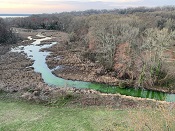
On March 20, 2020, around 7 a.m., several FODMers observed that the water in west Dyke Marsh and an unnamed stream flowing in the marsh was neon green. This part of the marsh is around 15 to 20 acres and west of the George Washington Memorial Parkway.
We contacted local, state and National Park Service officials. Fairfax County sent wastewater and hazardous materials staffers, the Virginia Department of Environmental Quality sent pollution experts and the National Park Service sent a staffer, all to inspect the site.
Restoring Peregrine Falcons to Virginia’s Mountains

On March 1, 2020, Shenandoah National Park biologist Rolf Gubler described the peregrine falcon (Falco peregrinus) restoration project to a packed room of 80 enthusiasts. This project in the park is a partnership of the National Park Service (NPS), William and Mary College’s Center for Conservation Biology (CCB), the Virginia Department of Game and Inland Fisheries (DGIF) and the Virginia Department of Transportation (VDOT).
Ross's Goose, a New Record
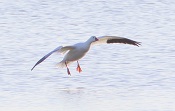
In early January 2020, FODMer Ed Eder photographed a rare visitor flying over Dyke Marsh, Ross’s goose (Anser rossi), which National Park Service biologist Brent Steury said was a new record sighting for the George Washington Memorial Parkway.
This goose is white with black wingtips and considered the smallest of the "light" or snow geese. Ross's goose has a short neck, rounded head and a stubby bill with no "grin patch" seen in its larger cousins due to their curved tomium, the cutting edge of the bill, Ed explained. More mature birds, particularly males, have warty gray tubercles at the base of their bills, said Ed.
Dyke Marsh in the News
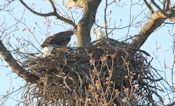
On December 2, 2019, the Fort Hunt Herald newspaper published an interview with FODM President Glenda Booth, in which she discusses the marsh restoration project, emerald ash borer infestation, the native plants project, bald eagles and more. Visit here to read the entire article.
Wildlife in a Changing Climate

On November 13, 2019, at FODM’s quarterly meeting, Dr. Sally Valdes outlined several ways that climate change is adversely affecting wildlife. Introducing the topic, she said that carbon dioxide and other greenhouse gas emissions have risen to levels unprecedented in the last 800,000 years. Carbon dioxide concentrations have been tracked continuously at the Mauna Loa Observatory in Hawaii since 1958 and the trend has been steadily upward, from about 315 parts per million (ppm) to 414 ppm in the spring of 2019.
Enhancing the Native Plant Project
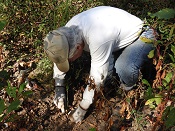
On October 11, 2019, FODM volunteers and National Park Service staff put in 400 more native plants in the native plant restoration area in Dyke Marsh, a .65-acre plot on the west side of the Haul Road trail. The group planted riverbank wild rye (Elymus riparius), New York ironweed (Vernonia noveboracensis), wild rice (Zizania aquatica) and deer tongue (Dichanthelium clandestinum (syn. Panicum clandestinum)).
FODMer Saves Bats

FODM Board of Directors’ member Deborah Klein Hammer saves bats and is featured in a September 16, 2019, article in “DCist” here.
Deborah studies Brazilian freetail (Tadarida brasiliensis) and Seminole bats (Lasiurus seminolus) in Dyke Marsh. Around 2013, a Brazilian free-tailed bat came into care of the Save Lucy Campaign (www.savelucythebat.org/), an organization devoted to rehabilitating injured and orphaned bats and educating the public about the importance of bats.
Dyke Marsh Turns a Brilliant Yellow
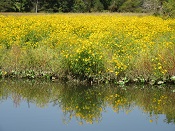
In the late summer and early fall, parts of Dyke Marsh turn a brilliant yellow. The yellow blossoms are typically plants in the family Asteraceae.
Many of the plants are Bidens laevis, common name, beggar-ticks, says botanist Dr. Elizabeth Wells, and she explains that they are restricted to low, wet places such as marshes. The name Bidens refers to the two teeth on each achene (Bidens = two (bi) teeth).
The Songs of Insects

Fall brings a “special orchestra” to the out-of-doors, began Wil Hershberger, at the September 11, 2019, meeting of the Friends of Dyke Marsh, at which Hershberger explored the songs and singing of crickets, katydids, grasshoppers (Orthoptera) and cicadas. In late summer and early fall, these singing insects fill the air with their courtship choruses.
Cardinal Flower, A Late Summer Burst of Red
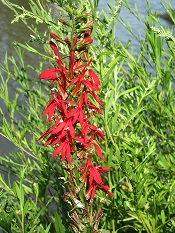
The brilliantly crimson cardinal flower (Lobelia cardinalis) brightens the marsh in late summer and early fall. A perennial, it typically stands erect, rising from a tangle of green foliage and commands attention because of its scarlet hues. It can be from one to six feet tall.
Wild Rice Provides a Fall Feast
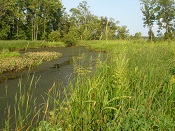
In late summer and early fall, Dyke Marsh’s wild rice (Zizania aquatica) is a shimmering panorama of green in the breeze. It is a native, annual, emergent, light green grass with flower clusters on broom-like branches. Wild rice thrives in soft, muddy areas and can grow to eight to 10 feet tall.


AlbertHerring-b4cc6b5cfb.jpg)



 Friends of Dyke Marsh, Inc. is a non-profit 501(c)(3) organization.
Friends of Dyke Marsh, Inc. is a non-profit 501(c)(3) organization.